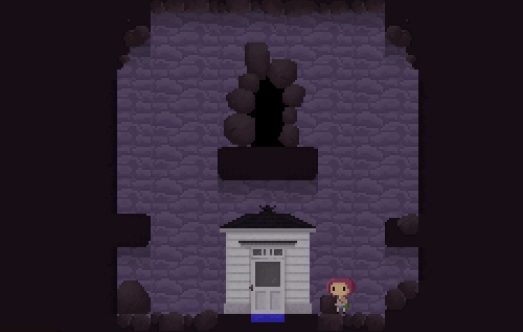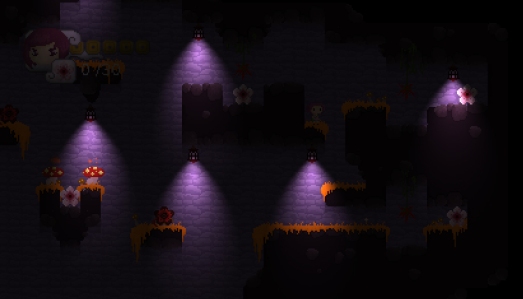If the difficulty is poorly tuned, the game can become either impossible or boring.
Today I’ve been designing and building the cave sections of level two, which I’m planning on having two of in each stage. In level one, the caves were the level’s “mini dungeons” and contained many more strategically placed obstacles than the rest of the level, which in turn made the caves more difficult than other areas. I made sure that the level could be finished without actually having to enter a cave, although if a player wishes to collect all thirty blossoms in the level then they would have to! In level two I’ve made sure that the caves must be entered, by placing the end of the level at the exit of one of the caves.
The player finds the first cave fairly close to the beginning of the level, if they choose to move downwards where the path forks. You enter the cave here:

And exit the cave to here, which is a dead end unless the player has collected the 15 necessary blossoms:

The aim of the design is to be more difficult than the rest of level two, but also more difficult than the caves in level one. This creates a difficulty “curve” which the player must adapt to, although more game developers seem to agree that there is no actual curve in game difficulty most of the time! In the blog I’ve pulled the quote from above, one example of a difficulty curve is described like a staircase, rising at intervals but lying flat for a while afterwards. Mine consists more of peaks and troughs, as difficulty is increased by a higher level of obstacles in cave areas but is lowered again when outside. Because Hanami is likely to only have three main playable levels (and a fourth ender level), I’ve aimed to increase the difficulty fairly rapidly, so that the maximum level of difficulty is reached by the end of the game.

In this design, I’ve tried to include platforms specially designed to challenge the player. At the top of the cave, I’ve added sections where the player must time jumps between platform heights between the swings of the spike plant above them. This is based on a part of a level one cave which allowed much more room. This time, I’ve gradually decreased the available space each time the player encounters a swinging spike plant. Another little challenge I’ve included is placing blossoms between two mushrooms, so that the player must accurately land jumps in order to not get hurt by the obstacles on either side of them. Unlike my some of my previous cave designs, I found myself re-scaling and moving parts of this design around quite a lot when it came to place it into the level! This is its finished form in the level editor (the red blocks represent solid platforms)

In this next screenshot, you can see the increased difficulty in acquiring blossoms throughout the first part of the cave:

Throughout this cave the player must be constantly more aware of their surroundings and the timing of their moves. I’ve tried to keep a similar level of difficulty in the second cave of the level, which is an optional cave which doesn’t lead to anywhere else in the level. It is accessed by hopping across a few platforms before reaching the Koinobori Cafe in the levels south-east corner. As you can see, this part of the level still needs a fair amount of work doing to it!

I enjoyed designing this cave as it occupies a wider space than my previous caves which tend to travel vertically. Part of the challenge of this design is that the layout is almost symmetrical, apart from a few blockages caused by mushroom enemies which halt the play from progressing on one side or the other (unless they choose to take damage).

I’ve included some of the same sorts of challenges throughout this design, although I’ve increased the difficulty of this part slightly by creating a cave-bed that cannot be touched if the player falls/misjudges a jump etc. I considered creating a lake of poisonous liquid or some other such over-used game cliche, but for now at least I’ve ended up using my Hello Mushroom enemy to fill the bottom of the cave (as a result I’ve nicknamed this the mushroom cave. I think it’s pretty.) I haven’t placed any blossoms in this cave yet, but I’ve planned for one to go at the bottom of the cave on the left hand side. On the other side, the player is simply met with yet more mushrooms!
This is definitely the hardest part of the game so far, possibly even the hardest I will make. The difficulty is due to a mix of difficult jumps, awkwardly placed obstacles and the inability to fall safely!















